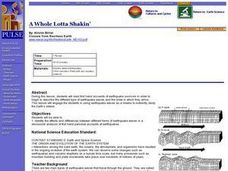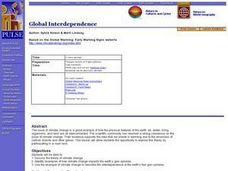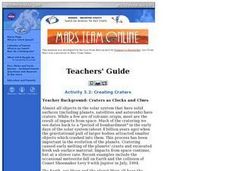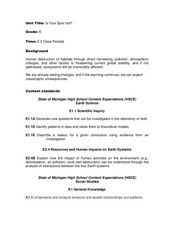Curated OER
Meteorite Musters
In this science worksheet, students conduct an experiment to collect small particles that come down in the rain or hail that are left over meteorites.
Curated OER
Weather Anomalies
Ninth graders participate in a simulation of a select scientific team from the National Oceanic and Atmospheric Administration (NOAA).
Curated OER
High Mountain Retreat
Learners explore and analyze atmospheric conditions for a high mountain retreat. They examine the relationship between altitude, atmospheric pressure, temperature and humidity at a particular location. In addition, they write reports...
Curated OER
Analyzing Meteorological Data From Mars
Young scholars compare real-time Earth and Mars measurements for temperature, wind speed, humidity and atmospheric pressure by accessing Internet-data resources from NASA. They access real-time weather data and maps for their school...
Curated OER
A Whole Lotta Shakin'
Students read first hand accounts of earthquake survivors in order to begin the describe the different types of earthquake waves and the order in which they arrive. They engage in using earthquake waves as a means to indirectly study the...
Curated OER
World Geography: Global Interdependence
Students are able to discuss the theory of climate change. They identify examples of how climate change impacts the earth's geo-spheres. Students are able to use the example of climate change to describe the interdependence of the...
Curated OER
Greenhouse Gases: The Chemistry Behind the Culprits
Ninth graders investigate the effect of different gases in the atmosphere. In this chemistry lesson plan, 9th graders explain how these gases contribute to global warming. They suggest possible solutions to this growing problem.
Curated OER
Local Weather And Location
Students explain how uneven heating of Earth affects wind and water currents. They describe the limits on current technology in predicting weather and how the Water Cycle is related to local weather.
Curated OER
Water Cycle
Ninth graders explore ways water moves through various reservoirs on Earth, examine how human activities change water cycle, investigate substances present in water that indicate human activity, and discuss how understanding water cycle...
Curated OER
Our Savage Planet in the News
Young scholars research volcanoes, storms, atmospheric conditions and extreme environments. They collect information and create a simulation of a science newscast. They watch a video and write a letter as an eyewitness to an avalanche.
Curated OER
Weather Investigation Through The Internet
Students explore the Earth's climatic regions and their characteristics. Using the Internet, they evaluate regional vegetation, agriculture, and population density. Students name and describe instruments that measure weather. They...
Curated OER
Math in Science-The Pressure is On
In this pressure learning exercise, students find the pressure of objects using the equation for pressure. They find the pressure of air in the atmosphere and the pressure of water in the ocean at different depths.
Curated OER
Round and Round-The Water Cycle
Students explore the water cycle. In this earth science activity, students work in small groups to read various books on the water cycle and take notes on chart paper. Students share their notes and teach a younger audience what they...
Curated OER
Creating Craters
Students explore parts of an impact crater and compare and contrast craters found in Earth, the Moon, and Mars. Crater formation is modelled and the relationship of mass, velocity, and size of the projectile to the crater formation is...
Curated OER
Spaced Out
Students are introduced to the space environment. This lesson plan covers the major differences between the environment on Earth and that of outer space and the engineering challenges that arise because of these discrepancies. In order...
Curated OER
Global Distribution of Water
In this water instructional activity, students are given the percent of distribution of water on earth. With the total amount of water equal to 1,000ml students determine the number of ml for each type of water on earth and color a...
Curated OER
Follow the Sun
Students use a simple model of the Earth and Sun as seen from space to explore the sun's apparent movement across the sky over the course of a day and year. They consider the apparent direction of movement and changes in the sun's angle.
Curated OER
Is Your Spot Hot?
Eighth graders explore global warming. In this Earth Science lesson plan, 8th graders will look for Harbingers and fingerprints for different areas. The students will identify an area at risk and they will then create a...
Curated OER
Is There Water on Mars?
Young scholars decide whether or not there is or has even been water on Mars. They analyze temperature and pressure data from the Pathfinder mission to Mars, and then they analyze images of Mars, interpreting the landforms they see and...
Curated OER
'Round and 'Round it Goes!
Students discuss and interpret background knowledge on poster copy given on the water cycle. Students complete the included activity sheets using the poster as a reference in small groups. Students identify and name where water can be...
Curated OER
Carbon Monoxide and Population Density
Tenth graders investigate the carbon monoxide level at a fixed latitude to determine if there is a relationship to population density. They download data sets and generate a graph, and find locations using the Earth's coordinate system....
Curated OER
Ocean Water
In this ocean water worksheet, students use 6 given terms related to ocean water, early Earth and ocean components to complete the sentences. They also answer 4 questions about seawater, the effects of volcanoes on oceans and ocean life.
Curated OER
The Effects of Storms
An excellent way to review a chapter or unit on storms, this worksheet features vocabulary review (gust, evacuation, storm surge, salinity), concept review (effects and details about hurricanes), skills/process review (normal high tide...
Curated OER
Chemistry in Action
In this chemistry in action instructional activity, students read about sulphuric acid, the use of metals, the production of titanium and the detection of chemical elements and compounds. Students are given 8 statements about what...
Other popular searches
- Layers of Earth's Atmosphere
- Earths Atmosphere Layers
- Layers of Earths Atmosphere
- Earth's Atmosphere Layers
- Energy Earth's Atmosphere
- Energy in Earth's Atmosphere
- Earth's Atmosphere Lessons
- Earth's Atmosphere Model
- Earths Atmosphere Activities
- Earths Atmosphere + Layers
- Earth's Atmosphere + Layers
- Earth's Atmosphere Lab

























